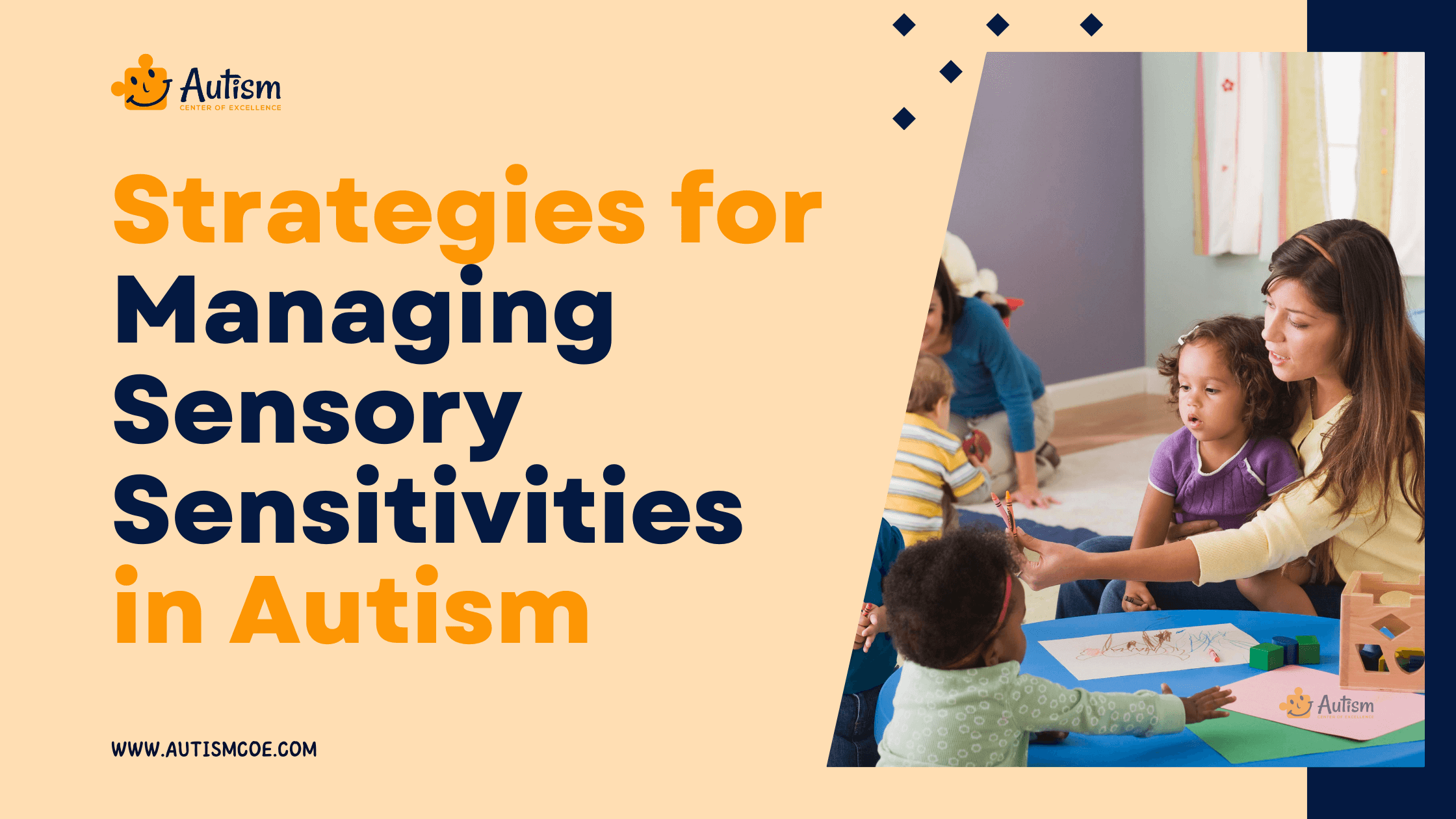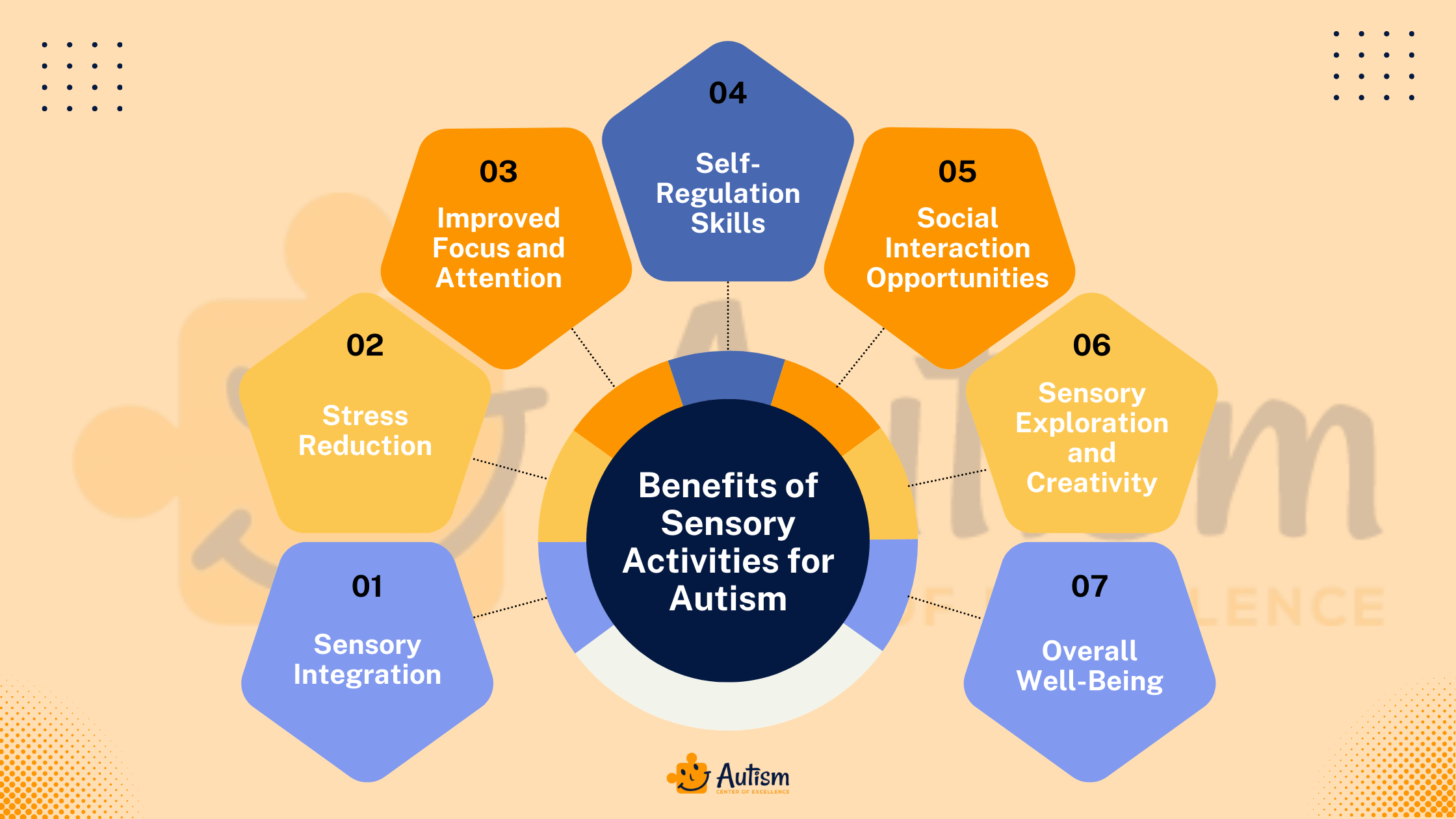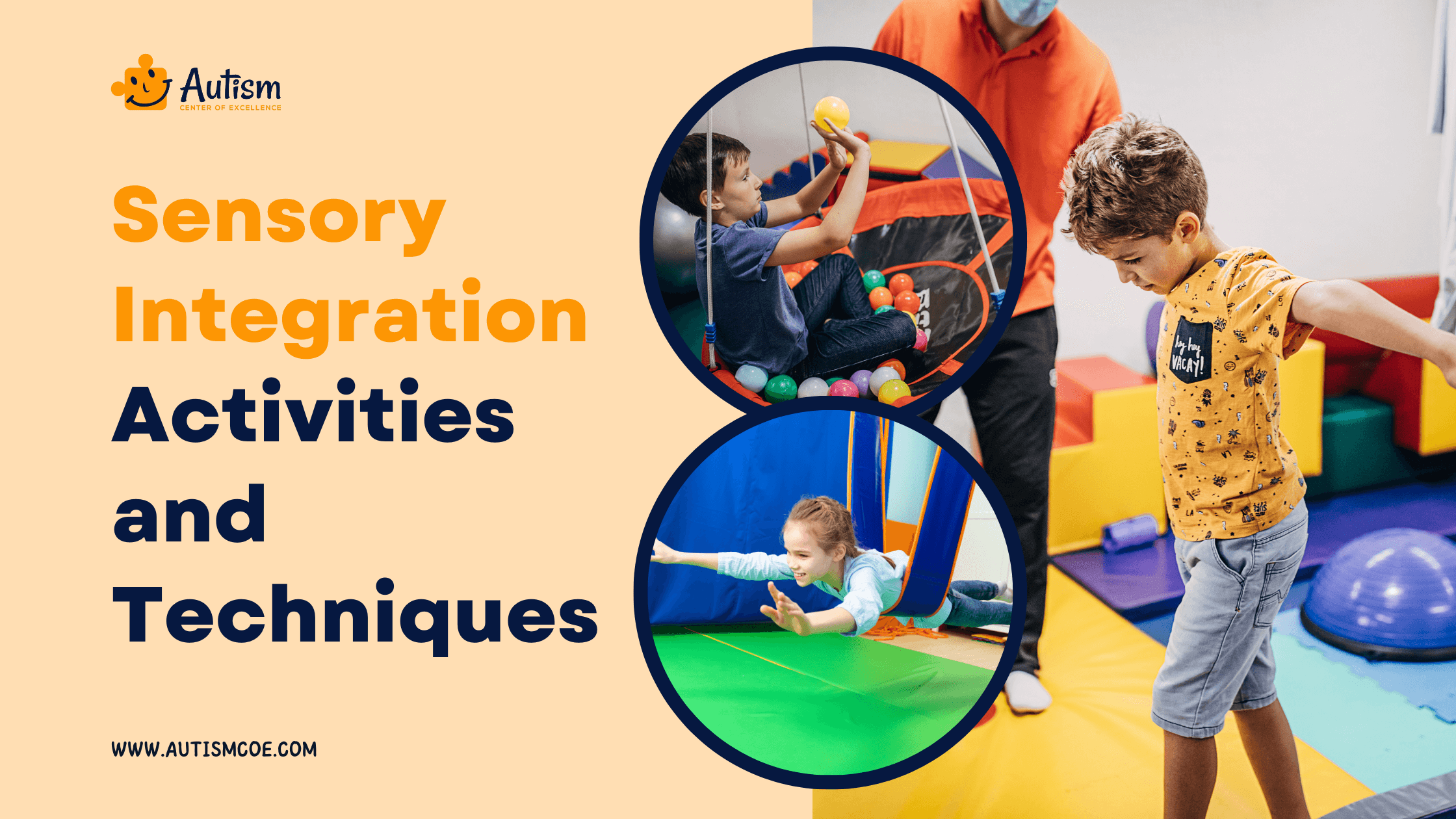The challenges that Autism Spectrum Disorder (ASD) poses include impairments in social communication, repetitive behaviors, and sensory sensitivities. Sensory sensitivities, which change reactions to stimuli such as sights, sounds, and textures, are common in ASD. Control of these sensitivities is essential for enhancing standard of living of children with autism. Sensory sensitivity in autism is diverse, with some children exhibiting hypersensitivity, while others acting hyposensitivity to sensory input. Untreated sensitivities result in stress, anxiety and problems in everyday routine and social life. This article aims to discuss practical approaches of managing sensory sensitivities in autism, so as to increase well-being and to help children with the spectrum.
Understanding Sensory Sensitivities in Autism
Sensory sensitivities are very characteristic of Autism Spectrum Disorder (ASD), that they dictate how children react and relate to environment stimulation. We will now explore why sensory sensitivities pertain to those with ASD and how they can be affected differently.
Explanation of Sensory Sensitivities:
In autism, the condition called sensory sensitivities, which means sensitivity to senses that process visuals, sounds, smells, tasting, touching and textures. Children with ASD find themselves responding to sensory input differently, and that may be either hypersensitivity or hyposensitivity.
- Hypersensitivity: Some children with autism are hypersensitive, in other words they have exaggerated reactions to sensory inputs. For instance, they could find some noises intolerable such as loud music or talk in the background. High lights or strong odors can also prove too much for them and cause them discomfort or distress.
- Hyposensitivity: However, in some children, with autism, they may have hyposensitivity a situation in which they have decreased sensitivity to sensory inputs. These individuals may search for strong sensory stimuli or perform ritualistic activities to excite their senses. For example, they may love deep pressure or need strong flavors and textures in food.
Common Triggers and Early Warning Signs:
Identification of the regular stimuli and early forming manifestations of sensory overload is very important for managing sensory sensitivities in autism. Some common triggers include:
- Loud noises: For example, sirens, vacuum cleaners, or a crowded place.
- Bright lights: Flashing light or strobe light.
- Strong smells: Fragrance, cleaning agents or specific kinds of food.
- Uncomfortable textures: Tough materials, particular labels on clothes, or food textures.
- Covering ears: Blocking out noise by covering ears with hands or objects.
- Avoidance: Attempting to ignore sensory triggers or isolating from overstimulating environments.
- Increased agitation: Some may become agitated, annoyed, or anxious because of environmental stimulation.
- Self-stimulatory behaviors: Performing repetitive motions or activities to manage sensory input, for example, hand flapping or rocking.
The knowledge of sensory sensitivities and their diverse presentations in autism is essential in adopting successful approaches to help children who have spectrum to control the sensorial surfeit and to support their well-being. Next, we will consider practical methods of dealing with sensory sensitivities in autism.

Impact of Sensory Sensitivities on Children With Autism
Sensory sensitivities are not minor irritations for children with Autism Spectrum Disorders (ASD); they disrupt their daily lives. Let us consider how sensory sensitivities affect various areas of life in children with autism.
Social Interactions:
Children with autism often experience sensory sensitivities that can complicate social interactions. Sudden noises, flashing lights, or too many people can be discomforting and annoying and make one withdraw or avoid social places. Having rather a problem with dealing with sensory input makes conversation more than a challenge, and even difficult to engage with others.
Daily Activities:
Children with Autism Spectrum Disorder are often overwhelmed by sensory sensitivities on a routine basis like getting dressed, eating, bathing, or participating in any other normal daily activities. Discomfort may be caused by some clothing tags, seams, or specific fabrics, leading to aversions of clothing or refusal to wear particular items. Someone can develop an aversion towards a particular food due to its strong smell or when it has a peculiar food texture which makes the eating time stressful.
Learning and Academic Performance:
Sensory sensitives in Autism may have a negative influence upon learning and academic performance in autism spectrum children. The overstimulation inside the classroom, for example, with the use of fluorescent lights, sound, or noise, may distract children and disrupt their focus and attention. Other anxiety-driven or melt-down behaviors could develop from the inability to tolerate sensory input and interfere with learning participation.
Emotional Regulation:
Emotional regulation and behavior of children with autism might be affected by sensory sensitivities. Over-stimulation from stimuli can lead to increased irritability, anxiety, or agitation. Problems of sensory processing can cause emotional dyscontrol and meltdowns which render it difficult to handle stress or frustration in a proper way.
Independence and Quality of Life:
Dealing with sensory sensitivities is crucial because this makes an autistic child get used to an independent way of life and will end up improving their lives. Unmanaged sensory sensitivities may limit participation in everyday activities, social connections, and community engagement. By sensing sensory sensitivities and through the technique of sensory binding, autistic children are able to become more free and happy in their daily lives.
Sensory sensitivity’s impacts on day-to-day life are vital in developing strategies and interventions that address sensory overload and improve the quality of life of children with autism.

Strategies for Managing Sensory Sensitivities in Autism
Sensory sensitivities in Autism are impossible to deal with, but there are strategies that can be used to manage sensory sensitivities and provide positive reinforcements. Let’s explore some practical strategies for managing sensory sensitivities in Autism:
✅ Identify Triggers:
Recognition of sensory sensitivities in Autism is the first step in managing it. Notice the environments, situations, or stimuli that continually bring about discomfort or overload to children with autism. Common triggers include loud noises, bright lights, strong smells, and some textures.
✅ Create a Sensory-Friendly Environment:
Modify the environment in order to reduce the sensory sensitivities in Autism and make a pleasant place for the children suffering from autism. This may include:
-
-
- Using gentle light instead of hard fluorescent light.
- Eliminating the background sound or giving out earphones that cancel the noise.
- Getting rid of strong-smelling or distracting items.
- Sensory-friendly seating area or quiet place.
-
✅ Provide Sensory Breaks:
Allow children with autism to have sensory time-outs to help them manage their sensory input and prevent them getting overwhelmed.
-
-
- Deep pressure activities that include blankets with added weight or vests with compressions.
- Proprioceptive off-label activities including gross motor activities or pushing/pulling objects.
- Promote activities like swinging or rocking.
-
✅ Offer Sensory Tools and Supports:
With tools and assistance, sensory sensitivities in Autism can be trained to deal with sensory overload. This may include:
-
-
- Sensory fidget tools or stress balls are used in order to improve attention.
- Visual schedules or social stories to prepare children for sensory-rich experiences and transitions.
-
✅ Teach Coping Strategies:
Show children with autism methods they can employ to by themselves to learn to cope with sensory overload. This may include:
-
-
- Deep breathing exercises or mindfulness techniques that help children with autism to calm and reduce anxiety.
- Self-regulation techniques by means of progressive muscle relaxation or grounding exercises.
- Verbal or visual cues that they need a break or are becoming overwhelmed.
-
✅ Encourage Sensory Diet Activities:
Develop sensory diets collaborated with occupational therapists which include activities to achieve children’s sensory needs throughout the day.
-
-
- Sensory integration activities, for instance, brushing or joint compression.
- Static duties like heaving lifting and cart pushing/pulling.
- Sensory bins, water play, or playdough soothing activities.
-
These interventions allow working together of caregivers, educators and children with autism so that they create environments that calm and help children regulate sensory sensitivities in Autism, thus, enhancing the lives of the children.
Join Our Weekly Newsletters!
Subscribe now to stay updated with our latest email updates.

Benefits of Sensory Activities for Autism
Sensory stimulations are important for managing sensory sensitivities in children with Autism Spectrum Disorder (ASD). Therefore, these activities have the benefits of a sense of control and well–being. Let’s discuss the advantages of sensory activities for an autism spectrum child will be considered.
1️⃣ Sensory Integration:
Sensory activities help children with autism improve their ability to integrate and interpret sensory information. Engaging in sensory-filled activities enables children to acquire the vocabulary of various sensations and to become desensitized to overwhelming sensory input.
2️⃣ Stress Reduction:
Sensory activities have a calming effect on children with autism, as a result, stress and anxiety are reduced. Activities like deep-pressure massage, swinging, or rocking can calm and regulate the nervous system, thus reducing stress and tension.
3️⃣ Improved Focus and Attention:
Sensory activities enhance concentration and focus for children with autism. Stimulation of the brain by sensory input, promotes alertness, hence children are provided with an ability to focus and participate in tasks or activities.
4️⃣ Self-Regulation Skills:
Sensory activities help children with autism to learn self-regulation, which enables them to manage their sensory experiences and feelings. Engagement in sensory activities makes children aware of when they are over-stimulated and how to regulate their sensitive input and feelings.
5️⃣ Social Interaction Opportunities:
Sensory activities act as a socialization and communication platform for children with autism. However, occupying sensory-based play or group activities helps children to interact with a group of other children in a non-hostile, fun-filled setting, thereby enhancing social skills and relationships.
6️⃣ Sensory Exploration and Creativity:
Sensory activities allow sensory exploration and imagination which, in turn, enable autistic children to express themselves and participate in pretend play. Sensory bins, art projects, or outdoor exploration are activities that help children experience a variety of textures, colors, and sensations and, thus, develop their senses and creativity.
7️⃣ Overall Well-Being:
Doing sensory activities leads to overall improvement of autistic children’s lives since they can have a break, play, and communicate. The sensory environment promotes the whole state of joy, comfort arrangement feeling, and satisfaction within the whole quality of life.
Incorporation of sensory activities into daily routines and environments is imperative in managing sensory hypersensitivity and promoting the general health and well-being of children with autism. Recognizing the meaning of sensory activities and incorporating them into support plans can enable children with autism to be successful and fulfill their potential.

Sensory Integration Activities and Techniques
Sensory integration activities and techniques are important for children with Autism Spectrum Disorder (ASD) to organize their sensory experiences and to promote a balanced life. Let us look at some practical sensory integration activities and methods that can help to address sensory sensitivities in autism.
Proprioceptive Activities:
Proprioceptive activities are those which offer input to the muscles and joints and help children with autism to learn body awareness and coordination. Examples of proprioceptive activities include:
-
-
- Heavy work tasks: Participating in activities that include activities to push, pull or lift something heavy, for instance, carrying grocery bags or pushing cart load.
- Wall push-ups or chair push-ups: Pressing against a wall or a chair is good for providing proprioceptive input and muscle strengthening.
- Tactile stimulation: Using the tactile input provided by means of such activities as brushing or massage children may have their sensory system organized.
-
Vestibular Activities:
Vestibular activities are based on movement and balance, by engaging the vestibular system and integration. Examples of vestibular activities include:
-
-
- Swinging: Vestibular input to the system can be soothing if it is delivered in a pendulum or rotational fashion.
- Rocking: Swaying on a rocking chair or a therapy ball can help children self-regulate as well as keep balance.
- Balance activities: The vestibular system is challenged with the balance beam balancing or of walking on surfaces with an unequal level and thus helps in coordination.
-
Tactile Activities:
Tactile activities promote touch exploration, benefiting children who have the problem of either over or under sensitivity to different textures.
-
-
- Sensory Bins: Put containers with rice, beans, water beads, or sand, and place objects inside for a tactile exploration activity.
- Messy Play: Tactile experiences from playing with foam, slime, clay, or finger paints are varied.
-
Auditory Activities:
Designed to help with sound processing, these can include:
-
-
- Listening to Music: Particularly with headphones or in a silent surrounding.
- Sound Identification Games: Perception and labeling of sounds of the environment.
-
Mindfulness and Relaxation Techniques:
Children may benefit from practicing mindfulness and relaxation techniques, which allow them to relax their mind and body, thus lowering stress and promoting sensory regulation. Examples of mindfulness and relaxation techniques include:
-
-
- Deep breathing exercises: Taking deep breaths to achieve the relaxation and reduce the anxiety.
- Progressive muscle relaxation: Sequential tensing and relaxing of muscle groups aimed at relief of tension and facilitation of relaxation.
- Guided imagery: Visualization techniques that help in creating soothing mental images and inducing relaxation.
-
Visual Motor Integration Activities:
These activities help improve coordination between what the eyes see and how the body moves: These activities help improve coordination between what the eyes see and how the body moves:
-
-
- Puzzles and Building Blocks: To improve visual-spatial skills.
- Tracing and Drawing: On different surfaces or which are specially engineered for such use.
-
Sensory integration activities, practices, and techniques during the day in varied environments can be very useful for children who have autism who then get a chance to regulate themselves, relax, and enjoy. With the consideration of the distinct sensory needs of children with autism and the provision of customized sensory supports, caregivers, educators and therapists can enable children to prosper and excel in their everyday life activities.
Frequently Asked Questions & Answer
Does Sensory Issues Mean Autism?
Sensory issues alone do not necessarily mean autism. While sensory issues are commonly associated with Autism Spectrum Disorder (ASD), they can also occur in individuals without autism. Sensory issues refer to difficulties processing sensory information, such as sights, sounds, smells, tastes, textures, and touch.
Are Sensory Issues a Sign of Autism?
Sensory issues can be a sign of autism, as they are a common feature of Autism Spectrum Disorder (ASD). Many individuals with autism experience sensory sensitivities or difficulties processing sensory information. However, sensory issues can also occur in individuals without autism and may be associated with other conditions or sensory processing disorders.
How Sensory Processing Disorder is Diagnosed?
Sensory processing disorder (SPD) is diagnosed through comprehensive evaluation by healthcare professionals, such as occupational therapists or developmental pediatricians. The diagnosis typically involves assessing a person’s sensory responses and behaviors across different sensory modalities, including touch, taste, smell, sight, and sound. Observations, standardized assessments, and parent or caregiver reports are often used to evaluate sensory processing difficulties.
What is Sensory Autism?
Sensory autism, or sensory processing differences in autism, refers to the unique ways individuals with autism process and respond to sensory stimuli. Many individuals with autism experience sensory sensitivities, which can manifest as hypersensitivity (over-responsiveness) or hyposensitivity (under-responsiveness) to sensory input. Sensory autism encompasses a range of sensory experiences and challenges that may vary among individuals on the autism spectrum.
What Are Sensory Sensitivities?
Sensory sensitivities refer to heightened or diminished responses to sensory stimuli, such as sights, sounds, smells, tastes, textures, and touch. Individuals with sensory sensitivities may experience discomfort, anxiety, or distress in response to certain sensory input. Sensory sensitivities are common in Autism Spectrum Disorder (ASD) but can also occur in individuals without autism. They can significantly impact daily life and may require strategies for managing sensory overload and promoting sensory regulation.
Conclusion
Managing sensory sensitivities in autism is essential for enhancing the well-being and quality of life of children on the spectrum. By understanding the unique sensory experiences of children with autism and implementing effective strategies, caregivers and educators can support sensory regulation. We explored various strategies for managing sensory sensitivities, including creating sensory-friendly environments, providing sensory breaks, and offering sensory tools and supports. We also discussed the benefits of sensory activities, such as stress reduction and improved focus. Autism Center of Excellence can provide valuable resources and support for children with autism and their families. AutismCOE offers ABA Therapy, Autism Early Intervention Program, Autism School Readiness Program, Speech Therapy, and Occupational Therapy services for children aged 2 – 14 years in-home as well as in center-based environments. Let’s work together to create inclusive environments that promote sensory comfort and happiness for children on the autism spectrum, with organizations like AutismCOE providing valuable support along the way.
Please Note: The content of this blog is for informational purposes only and should not be considered a substitute for professional medical advice, diagnosis, or treatment. Consult a qualified health care professional for personalized guidance tailored to your specific situation.

Bhavika Bhasin (Author)
Bhavika Bhasin is the Research and Marketing officer at AutismCOE. She works with children and adults with ASD. Her clinical research includes evaluating various available autism screening and diagnosis methods and their efficacy. She is currently developing a novel screening exam that is indicated to be more accurate than the existing available exams. She is also writes articles papers for various publications.


